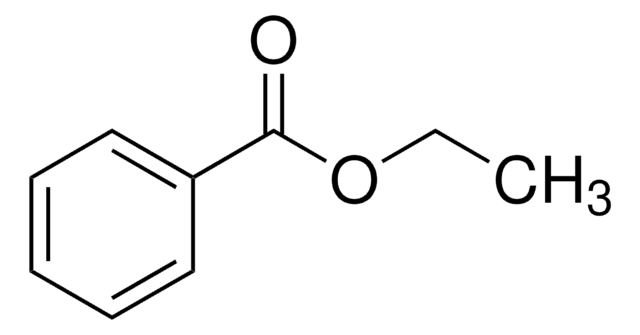72505
Ethyl benzoate
analytical standard
About This Item
Produits recommandés
Qualité
analytical standard
Niveau de qualité
Densité de vapeur
5.17 (vs air)
Pression de vapeur
1 mmHg ( 44 °C)
Essai
≥99.0% (GC)
Température d'inflammation spontanée
914 °F
Durée de conservation
limited shelf life, expiry date on the label
Technique(s)
HPLC: suitable
gas chromatography (GC): suitable
Impuretés
≤0.5% water
Indice de réfraction
n20/D 1.504 (lit.)
n20/D 1.504-1.506
pb
212 °C (lit.)
Pf
−34 °C (lit.)
Densité
1.045 g/mL at 25 °C (lit.)
Application(s)
cleaning products
cosmetics
flavors and fragrances
food and beverages
personal care
Format
neat
Chaîne SMILES
CCOC(=O)c1ccccc1
InChI
1S/C9H10O2/c1-2-11-9(10)8-6-4-3-5-7-8/h3-7H,2H2,1H3
Clé InChI
MTZQAGJQAFMTAQ-UHFFFAOYSA-N
Vous recherchez des produits similaires ? Visite Guide de comparaison des produits
Catégories apparentées
Description générale
Application
- Japanese soy sauce by headspace solid-phase microextraction-aroma extraction dilution analysis-gas chromatography-olfactometry (HS-SPME-AEDA-GC-O) as well as GC combined with mass spectrometry (GC-MS).
- Honeybush tea (Cyclopia spp.) by HS-SPME and comprehensive two-dimensional gas chromatography (GC x GC) with time-of-flight mass spectrometry (TOFMS).
- Cherry wine samples by HS-SPME coupled to GC-MS equipped with electron impact (EI) ionization, and selective ion monitoring (SIM) detection.
- Monstera diliciosa fruits by HS-SPME-GC with quadrupole EI-MS.
Code de la classe de stockage
10 - Combustible liquids
Classe de danger pour l'eau (WGK)
WGK 1
Point d'éclair (°F)
190.4 °F - closed cup
Point d'éclair (°C)
88 °C - closed cup
Faites votre choix parmi les versions les plus récentes :
Déjà en possession de ce produit ?
Retrouvez la documentation relative aux produits que vous avez récemment achetés dans la Bibliothèque de documents.
Les clients ont également consulté
Notre équipe de scientifiques dispose d'une expérience dans tous les secteurs de la recherche, notamment en sciences de la vie, science des matériaux, synthèse chimique, chromatographie, analyse et dans de nombreux autres domaines..
Contacter notre Service technique














